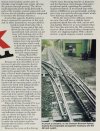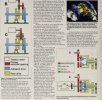RedPostJunc
Member
Apologies if this has been asked before, I did various searches and could not find anything relevant.
I have just returned from holiday in Switzerland and my travels included some rack railway travel. On some rack lines the whole network is racked, but on the line between Visp and Zermatt the steep bits are racked but the more level stretches are not racked.
There is a very noticeable bang and jolt as the train engages the rack. This made me wonder whether there is any wheel slide as the train engages the rack, even at slow speed?
I have just returned from holiday in Switzerland and my travels included some rack railway travel. On some rack lines the whole network is racked, but on the line between Visp and Zermatt the steep bits are racked but the more level stretches are not racked.
There is a very noticeable bang and jolt as the train engages the rack. This made me wonder whether there is any wheel slide as the train engages the rack, even at slow speed?


